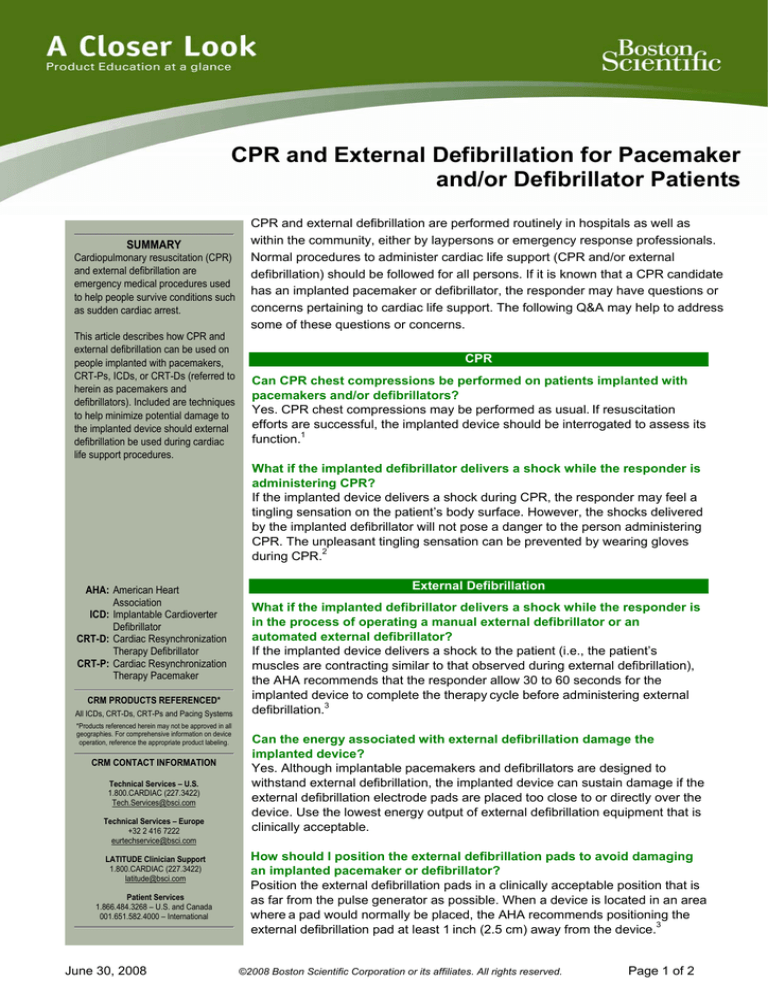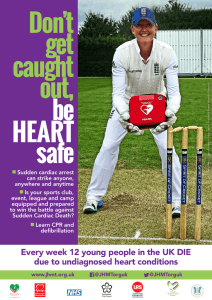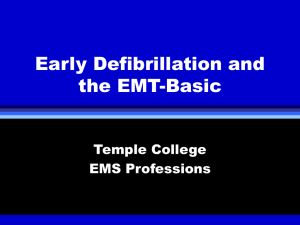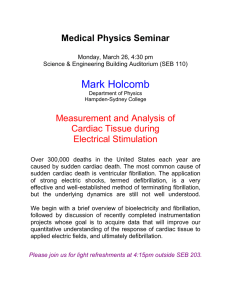
CPR and External Defibrillation for Pacemaker
and/or Defibrillator Patients
SUMMARY
Cardiopulmonary resuscitation (CPR)
and external defibrillation are
emergency medical procedures used
to help people survive conditions such
as sudden cardiac arrest.
This article describes how CPR and
external defibrillation can be used on
people implanted with pacemakers,
CRT-Ps, ICDs, or CRT-Ds (referred to
herein as pacemakers and
defibrillators). Included are techniques
to help minimize potential damage to
the implanted device should external
defibrillation be used during cardiac
life support procedures.
CPR and external defibrillation are performed routinely in hospitals as well as
within the community, either by laypersons or emergency response professionals.
Normal procedures to administer cardiac life support (CPR and/or external
defibrillation) should be followed for all persons. If it is known that a CPR candidate
has an implanted pacemaker or defibrillator, the responder may have questions or
concerns pertaining to cardiac life support. The following Q&A may help to address
some of these questions or concerns.
CPR
Can CPR chest compressions be performed on patients implanted with
pacemakers and/or defibrillators?
Yes. CPR chest compressions may be performed as usual. If resuscitation
efforts are successful, the implanted device should be interrogated to assess its
function.1
What if the implanted defibrillator delivers a shock while the responder is
administering CPR?
If the implanted device delivers a shock during CPR, the responder may feel a
tingling sensation on the patient’s body surface. However, the shocks delivered
by the implanted defibrillator will not pose a danger to the person administering
CPR. The unpleasant tingling sensation can be prevented by wearing gloves
during CPR.2
AHA: American Heart
Association
ICD: Implantable Cardioverter
Defibrillator
CRT-D: Cardiac Resynchronization
Therapy Defibrillator
CRT-P: Cardiac Resynchronization
Therapy Pacemaker
CRM PRODUCTS REFERENCED*
All ICDs, CRT-Ds, CRT-Ps and Pacing Systems
*Products referenced herein may not be approved in all
geographies. For comprehensive information on device
operation, reference the appropriate product labeling.
CRM CONTACT INFORMATION
Technical Services – U.S.
1.800.CARDIAC (227.3422)
Tech.Services@bsci.com
Technical Services – Europe
+32 2 416 7222
eurtechservice@bsci.com
LATITUDE Clinician Support
1.800.CARDIAC (227.3422)
latitude@bsci.com
Patient Services
1.866.484.3268 – U.S. and Canada
001.651.582.4000 – International
June 30, 2008
External Defibrillation
What if the implanted defibrillator delivers a shock while the responder is
in the process of operating a manual external defibrillator or an
automated external defibrillator?
If the implanted device delivers a shock to the patient (i.e., the patient’s
muscles are contracting similar to that observed during external defibrillation),
the AHA recommends that the responder allow 30 to 60 seconds for the
implanted device to complete the therapy cycle before administering external
defibrillation.3
Can the energy associated with external defibrillation damage the
implanted device?
Yes. Although implantable pacemakers and defibrillators are designed to
withstand external defibrillation, the implanted device can sustain damage if the
external defibrillation electrode pads are placed too close to or directly over the
device. Use the lowest energy output of external defibrillation equipment that is
clinically acceptable.
How should I position the external defibrillation pads to avoid damaging
an implanted pacemaker or defibrillator?
Position the external defibrillation pads in a clinically acceptable position that is
as far from the pulse generator as possible. When a device is located in an area
where a pad would normally be placed, the AHA recommends positioning the
external defibrillation pad at least 1 inch (2.5 cm) away from the device.3
©2008 Boston Scientific Corporation or its affiliates. All rights reserved.
Page 1 of 2
Whenever possible, external defibrillation pads should be placed in an anterior-posterior position (Figure 1).
However, if the device is positioned in the left pectoral region, placement of the external defibrillation pads in the
anterior-apex position is also acceptable.4
Left pectoral implant showing acceptable
anterior-apex pad placement
Left or right or left pectoral implant showing
recommended anterior-posterior pad placement
View of anterior-posterior pad
placement
Figure 1. Placement of external defibrillation pads for pacemaker or defibrillator patients.
4
What is the best way to determine if the implanted device has been damaged by external defibrillation?
Following any episode of external defibrillation, proper function of the implanted device should be verified.
•
For implanted defibrillators—Interrogate the device, perform a manual capacitor reformation, verify
battery status, shock counters and pacing, and ensure that the programmable parameters did not
change. Note that if external defibrillation is applied, a warning message may be displayed upon
interrogation (Figure 2).
Figure 2. Warning message indicating greater
than 8 volts detected on the leads during two
consecutive charging cycles.
•
For implanted pacemakers—External defibrillation could cause a temporary battery voltage reduction,
which would cause the device to enter a reset condition. Should this occur, the programmer will display
a warning message upon interrogation (Figure 3). Reprogram parameter settings as desired.
Figure 3. Pacemaker reset message.
Where can additional information on CPR and external defibrillation be obtained?
The complete guidelines can be found by visiting the American Heart Association website at
www.americanheart.org.
1
Feature Articles page. Emergency Medicine Web site. Available at http://www.emedmag.com/html/pre/fea/features/039030030.asp. Accessed May 20, 2008.
McMullan J, Valento, M, Attari, M, Venkat, A. Care of the pacemaker/implantable cardioverter defibrillator patient in the ED. The American Journal of Emergency Medicine.
2007; 25: 812-822.
3
Circulation. 2005 American Heart Association Guidelines for Cardiopulmonary Resuscitation and Emergency Cardiovascular Care. American Heart Association Web site.
Available at http://circ.ahajournals.org/cgi/content/full/112/24_suppl/IV-35. Accessed June 25, 2008.
4
Woods S, Sivarajan Froelicher E, Underhill Motzer S, Bridges E. Cardiac Nursing. 5th ed. Philadelphia, PA: Lippincott Williams & Wilkins; 2004. Google Book
Search Web site. Available at
http://books.google.com/books?id=_vWmbeuYRN8C&pg=PA750&vq=external+defibrillation&dq=external+defibrillation+and+icds&source=gbs_search_r&cad=1_1&s
ig=gX49MamVUTqTh3siEgwe89rQX0o. Accessed June 25, 2008.
2
June 30, 2008
©2008 Boston Scientific Corporation or its affiliates. All rights reserved.
Page 2 of 2








